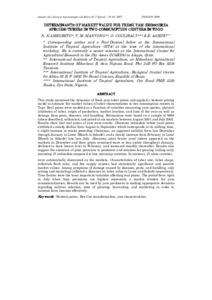| dc.contributor.author | Amegbeto, N.K. |
| dc.contributor.author | Manyong, Victor M. |
| dc.contributor.author | Coulibaly, O. |
| dc.contributor.author | Asiedu, Robert |
| dc.date.accessioned | 2019-12-04T11:15:42Z |
| dc.date.available | 2019-12-04T11:15:42Z |
| dc.date.issued | 2007 |
| dc.identifier.citation | Amegbeto, N.K., Manyong, V., Coulibaly, O. & Asiedu, R. (2007). Determinants of market value for fresh yam (Dioscorea species) tubers in two consumption centers in Togo. Annales des Sciences Agronomiques du Benin, 9(2), 29-48. |
| dc.identifier.issn | 1659-5009 |
| dc.identifier.uri | https://hdl.handle.net/20.500.12478/3016 |
| dc.description.abstract | This study examined the dynamics of fresh yam tuber prices and applied a hedonic pricing model to estimate the market values of tuber characteristics in two consumption centers in Togo. Real prices were modeled as a function of variables measuring yam species, physical attributes of tuber, origin of production, market location, and time of the year as well as damage from pests, diseases, and handling. Estimations were based on a sample of 9958 tubers described, calibrated, and priced at six markets between August 2001 and July 2002. Results show that real prices of yam were erratic. Dioscorea rotundata (white yam) prices exhibited a steady decline from August to September which corresponds to its milking time, a slight increase in weeks preceding Christmas, an apparent stability from late December through January in Lomé (March in Sokodé), and a steady increase from February in Lomé (March in Sokodé) into late July. Dioscorea alata (water yam) tubers appeared on the markets in December and their prices remained more or less stable throughout January, declined to their lowest level in February, and increased steadily thereafter. Results also suggest the existence of price premium to producers and retailers for growing /selling early maturing D. rodundata compared to late maturing varieties. In contrast, D. alata varieties were substantially discounted on the markets. Characteristics of tuber size, tuber shape, yellowish flesh color, and few supply sources had statistically significant and positive market values. Among symptoms of damage caused by diseases, pests, and handling, only rotting and mealybugs inflicted a discount on tuber value in Lomé and Sokodé respectively. Time factors were the most important variables affecting real prices. The period from April to July when time premiums are highest represents a market window for yam commercialization. Results can be used by yam producers in making appropriate decisions regarding cultivar selection, time of planting, harvesting, and marketing in order to increase farm incomes effectively. |
| dc.description.sponsorship | International Fund for Agricultural Development |
| dc.language.iso | en |
| dc.subject | Hedonic Prices |
| dc.subject | Box+Cox Transformation |
| dc.subject | Yams |
| dc.subject | Market Value |
| dc.subject | Harvesting |
| dc.subject | Yam Tuber |
| dc.subject | Consumption |
| dc.title | Determinants of market value for fresh yam (Dioscorea species) tubers in two consumption centers in Togo |
| dc.type | Journal Article |
| dc.description.version | Peer Review |
| cg.contributor.affiliation | International Center for Agricultural Research in the Dry Areas |
| cg.contributor.affiliation | International Institute of Tropical Agriculture |
| cg.coverage.region | Asia |
| cg.coverage.region | Africa |
| cg.coverage.region | West Asia |
| cg.coverage.region | East Africa |
| cg.coverage.region | West Africa |
| cg.coverage.country | Syria |
| cg.coverage.country | Tanzania |
| cg.coverage.country | Benin |
| cg.coverage.country | Nigeria |
| cg.authorship.types | CGIAR multi-centre |
| cg.iitasubject | Yam |
| cg.iitasubject | Smallholder Farmers |
| cg.iitasubject | Food Security |
| cg.iitasubject | Markets |
| cg.iitasubject | Domestic Trade |
| cg.iitasubject | Agribusiness |
| cg.iitasubject | Livelihoods |
| cg.iitasubject | Nutrition |
| cg.iitasubject | Handling, Transport, Storage And Protection Of Agricultural Products |
| cg.iitasubject | Farm Management |
| cg.iitasubject | Post-Harvesting Technology |
| cg.accessibilitystatus | Open Access |
| local.dspaceid | 94482 |

